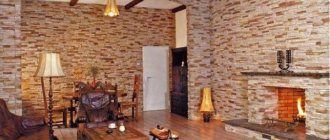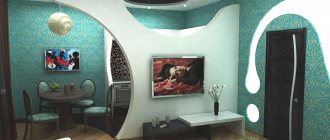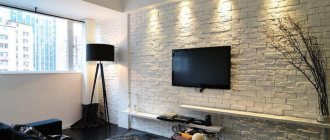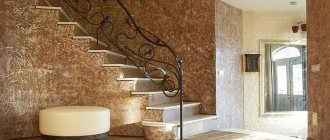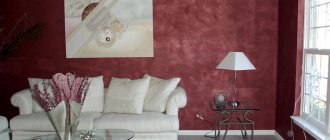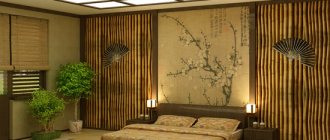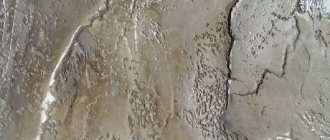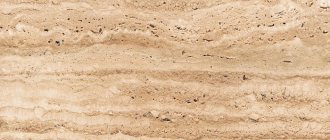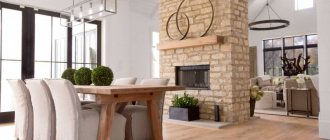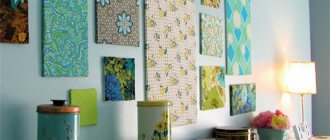Currently, brick wall decoration is becoming increasingly popular. It’s one thing when the walls actually consist of brick - then it’s enough to just knock off the plaster and refine the resulting wall surface. In all other cases, you will have to resort to one of the methods below.
ON A NOTE. This article discusses all the main methods of imitation, with the exception of plaster. You can read more about the technology of laying brickwork using plaster here.
Imitation brick from flexible tiles
Flexible tiles, which are rubber granules pressed together, are considered an excellent option for wall decoration. Such finishing is not afraid of natural disasters and physical influences. Flexible tiles are able to withstand any wall movements due to their elasticity. Therefore, it can be laid even on curved surfaces.
Material advantages
The advantages of flexible bricks on the wall include:
- Immunity to rotting processes and the effects of various microorganisms, which makes it possible not to block the finish from the passage of gases. This has a beneficial effect on the microclimate in the room.
- Presentable appearance of the finish - visually it is quite difficult to determine the material used.
- No need for special tools for laying tiles.
Flexible brick tiles
What is needed for finishing
To install decorative flexible tiles you need:
- primer;
- tile adhesive (for attaching bricks to the wall);
- notched trowel (for spreading tile adhesive);
- level (for leveling tiles during installation);
- dyeing thread (for marking);
- sharp scissors (for cutting tiles);
- two types of brushes: a maklavitsa, used when covering the surface with a primer, and a simple round brush with a diameter of 12 millimeters, which will help to wash the seams.
Notched trowel
How to mount on a wall
The process of laying flexible tiles is carried out in four stages:
- Marking in progress.
- Glue is applied to the wall surface.
- The tiles are cut and laid on the wall.
- The seams are washed away.
Installation of flexible tiles
Hard tile bricks
An imitation of a brick wall can be successfully achieved using hard tiles. There are various options for hard tiles; as a rule, they are all installed using identical technology.
Types of hard tiles
The following types of decorative bricks are considered the most popular:
- Gypsum tiles. Such tiles are most common among consumers. Due to the plasticity of gypsum mortar, bricks of various textures are produced. The disadvantages include the fragility of the material, as well as the inability to use in rooms with high humidity.
- Cement tiles. This material will be more expensive than gypsum tiles, but this type has a number of advantages, such as high strength, the possibility of installation in wet rooms, and susceptibility to care and washing.
- Clinker tiles. The most similar imitation of brick will be on the wall when using the clinker variety. The price tag for this tile is significantly higher than other options, but the difference in cost is offset by the following advantages: the possibility of cladding facades, high strength, resistance to abrasion and ultraviolet radiation.
Gypsum brick tiles
Tile installation technology
The rules and technology for facing a wall with hard tiles differ little from the technology for laying soft material. The difference will be hidden behind the thickness of the glue and the process of cutting the material. According to the first point, the thickness should not exceed 0.5 millimeters, and hard tiles can only be cut with diamond-coated circles. The exception is gypsum tiles - they are easy to cut with a knife.
Installation of rigid brick tiles
How to make a mold for casting plaster tiles
Brick finishes can be made from homemade tiles. To do this, you need to take an impression from several individual bricks, thereby preparing the mold for casting. A gypsum solution will be poured into the resulting form, after which the finished decorative stone can be mounted on the wall.
The side of the brick that is taken as a sample is covered with grease or heated wax mixed with kerosene. This is necessary in order to prevent the silicone from sticking to the surface. As soon as the layout dries, the treated side is covered with a layer of silicone sealant, 1-1.5 mm thick. The mold is set aside until the silicone has completely polymerized.
After the silicone has hardened, the mold is coated with polyurethane foam. After the foam has hardened, the sample is removed and the bottom of the mold is leveled.
A gypsum solution is poured into ready-made molds, which sets very quickly and takes on the appearance of a finished finishing material. If you have 10 molds, you can make several square meters of decorative stone in a couple of days.
Brick tile mold
Imitation brick made of polystyrene foam
An imitation of this material is perfectly fixed on the wall. In addition, polystyrene foam:
- easy to cut and process;
- does not generate dust, which is important when performing interior work;
- costs less than plaster.
The main negative point lies in the low resistance to mechanical stress.
Expanded polystyrene brick
Making the markings
There are two possible options for imitating brick using expanded polystyrene:
- Laying tiles in separate elements. The standard brick size is 250x120x65 mm. Thus, it is necessary to cut the sheet into tiles measuring 250x65 mm.
- Solid sheet masonry. Since foam plastic melts easily, a soldering iron is used to make seams and solder several sheets. The tool is used to pass along the seams of future bricks, having previously outlined the lines with a pencil. Particular care is needed when framing the corners of the bricks, as they must remain smooth and not get unnatural roundings.
Laying technology
Bricks are always mounted on the wall from the corner. Only then are the openings for windows and doors framed.
You can mount it directly on the wall using liquid nails, or on a plasterboard or plywood sheet. Next, such a sheet is fixed using self-tapping screws. This option is considered more convenient, since the bricks are fixed on a sheet lying on the floor, that is, the work takes place in a horizontal plane.
Installation of foam tiles
Painting and decor
You can either leave the foam texture or cover it with putty and give it a special texture of natural stone.
In any method, you will have to resort to priming the material. The choice of paint should be approached with special attention. The paint must be solvent-free, otherwise the surface may be damaged. The final result can be fixed using matte acrylic varnish.
sawing brick
The idea of replacing expensive “brick-like” finishing tiles with bricks loosened into plates seems reasonable. But you need good quality brick, without voids, inhomogeneities, underburning or burnt areas. In general, you need an expensive brick. Or old.
An example of sawn bricks... but these are two “beautiful” parts
It is better to cut it with a water-cooled circular saw. The result will be decorative brick-like tiles in a natural color. The thickness of the tiles is at least 8-10 mm. The advantages are clear: low price, no need to paint - there is a natural color. These homemade brick tiles are then glued to the walls using regular tile adhesive.
We lay out any texture from sawn bricks
For a more pronounced color, you can coat it with matte varnish.
And this is for decorating external corners
But there are also disadvantages: you need a good quality brick, but you still have to find it. When cutting, the plates may break. Only two of them are obtained with a beautiful surface - the extreme ones. The rest will have to be modified manually, creating relief. It’s tedious, dusty, time-consuming, difficult, and it’s not a fact that brick imitation will actually be learned “at the level.”
Despite all the shortcomings, this method is used. And this is, perhaps, the only option for homemade imitation brickwork that can be used for exterior decoration . For these purposes (finishing the facade of a building), by the way, you can cut the brick into two halves. Everything is cheaper than buying tiles.
Brickwork made of plastic panels
To imitate brickwork, you can take plastic panels that can cover a large area of the surface. Due to the large size, installation is greatly simplified. This is the main advantage of the material.
Plastic is one of the most resistant materials to any negative impact. It is for this reason that it is widely used in finishing rooms with high traffic.
Features of PVC panels
The main differences between volumetric plastic panels are the following material properties:
- high strength;
- quick installation and replacement of a broken part in case of deformation;
- high noise absorption;
- the ability to hide unnecessary structural elements, such as wires or pipes.
Brickwork from panels
How to lay it correctly
If the wall surface is not prepared and leveled, or there is a need to hide communications, you will have to make a special frame from metal slats or wooden beams.
If the surface has no blemishes, then plastic panels can be attached using liquid nails. When installing heavy blocks, self-tapping screws or cement are used.
Panel installation
Brickwork made from MDF panels
Due to their large dimensions (2440×1220 mm), MDF panels can be quickly and conveniently mounted on the wall. In rooms with low ceilings, one panel can cover the entire height of the wall.
In appearance and tactile sensations, MDF panels are more pleasant than plastic. However, this material is far from real brick; the imitation of a brick wall is given by the joints between MDF sheets.
MDF brickwork
Types of brickwork in the interior
There are more than a dozen types of brickwork, but only three of them are most often used in interior design.
Textured brick wall in the interior of the room
1. Spoon. The most common option: with this type, each subsequent row is laid with an offset of half or a quarter of the length of the brick.
Spoon-type brickwork in the interior
2. Cross. In this installation option, the rows of bricks alternate: first there is a row laid out with the long side, above it with the short side, then again with the long side, and so on.
Cross-type brickwork in the hallway interior
3. Chaotic. Bricks laid on the short side appear in chaotic patches among long blocks. This option is quite rare: most often it can be seen in old houses.
Chaotic brickwork in the living room design
When laying materials that imitate natural brick (for example, flexible tiles or clinker), you can create the effect of a cross or chaotic masonry by cutting the cladding elements in half and alternating them with standard ones.
Imitation of cross brickwork using wall panels
How to paint brick trim correctly
White brick finishing has become especially popular. This interior can be achieved by painting with a wide roller and a brush for the seams, or using a spray gun.
If the wall should not be monochromatic, then a small amount of tint is added to the base paint. This tone is applied to the surface.
If the color of the seams should look darker, then first of all the joints are brushed. Then the finishing surface is painted using a roller with a short pile length.
On a note. To get an unusual effect, you can dip a short-nap roller into a tray with silver paint and paint the protruding areas of the wall.
Painting a brick wall
Brick in the interior of various rooms
Decorative masonry is a stylish and original solution for your apartment, which will become the center of the entire space. In what rooms and interior styles does it look most impressive?
Brick wall in the living room
Brick wall in different rooms
The ideal place in the house for a brick wall is the living room: such a bright accent will certainly attract attention and will be an excellent topic for discussion with guests. This decor has the same effect in the hallway, where acquaintance with the house begins.
Brick accent wall in the living room interior
Decoration of hallway walls with brickwork
Bookshelves and cabinets make a harmonious pair with masonry: a library or office with such decor will immerse you in the pleasant atmosphere of antiquity.
Brick wall and bookshelves in a home office
Decorating a brick wall in a home library
Since brick is a rather cold material, it can make the room uncomfortable, so be careful when placing it in the private areas of the bedroom and nursery. The ideal option is to decorate the wall behind the head of the bed in this way (during rest, attention is concentrated on it least of all). Also give preference to light colors.
White brick walls look cozy in the bedroom, photo by Ivan Sorokin
Light brick walls look good in a children's room
Remember that not all materials are suitable for decorating a loggia, balcony and bathroom: before decorating these rooms, make sure that the chosen option has high moisture and frost resistance.
Brickwork in the bathroom
Brick walls on the balcony
A brick kitchen apron is a very trendy solution that will make your cooking area as stylish as in a fashionable restaurant. However, do not forget that this material requires constant cleaning, and some analogues are completely afraid of high temperatures (for example, plastic panels).
Light brick kitchen apron
Natural brick apron in kitchen design
Decorative masonry and interior style
The most popular style for decorating with brick is loft: decorative masonry perfectly emphasizes the industrial character of such an interior. Accent walls in a classic red shade look best here.
Brick wall decoration in a loft style interior
Decorative brick wall in a loft interior
Brick wall in the interior of a living room in loft style
White bricks look harmonious in Scandinavian style and scandi loft, and are also appropriate in minimalism (if the design of other walls looks as laconic as possible). For minimalism, painted options in dark colors are also suitable.
White brick column in Scandinavian style
White brick wall in a minimalist bedroom interior
Dark brick wall in a scandi-loft style interior
Unusual solutions are welcomed in a boho-style interior, so inserts in the form of decorative masonry would also be appropriate here. The color of the finish can be anything from neutral white to a bright accent color (for example, yellow).
Black brick in the interior of a living room in boho style
Brick wall in a boho style bedroom
Blue brick wall in a boho interior
In country houses in country or Provence style, brickwork looks stylish in both white and red. It is also suitable for American-style houses.
Brickwork in the design of a country style home
Decorating walls with bricks in a Provence style interior
How to paint brickwork using paint
During work, cover the baseboard and surrounding area with construction film. The boundaries of the masonry are outlined using tape. Then you can proceed directly to preparing the wall surface and further painting.
Important! When choosing a color, be aware that acrylic paints may darken after drying. It is recommended to do a test stain on a piece of material.
Drawn bricks
Surface preparation
Before applying paint, it is necessary to prepare the wall according to the recommendations above. Therefore, both eliminating unevenness of the original surface and priming the wall are important steps.
Drawing sequence and small tricks
Paint application proceeds according to the following scheme:
- White acrylic semi-matte paint is applied to the surface and left until completely dry.
- Background paint is being prepared. To do this, mix 1/6 umber, 1/6 black paint and 4/6 titanium white.
- On a dried wall, several rows of bricks are marked by hand.
- The imitation parts are painted with mixed ocher and sienna. This way you can get the popular brick shade.
- The traditional color can be obtained by mixing sienna, red ocher and adding white and a small amount of light ocher.
- The composition is applied with a sponge.
- Using an old toothbrush and burnt bone paint, a clay brick texture can be created. Simply dip the brush in the paint and spray it over the surface.
- To give volume to the masonry elements, the seams should be lined. To do this, a thin brush is dipped in a mixture of white and umber, and then passed along the seams.
The work is quite labor-intensive, so a beginner can draw no more than three dozen tiles in one day.
To obtain maximum realism of the painted wall, you can use the following life hacks:
- To reduce the harshness of the shadows around the brick, you can soak a toothbrush in white and natural sienna, and then blend the shadows with this brush.
- After applying the paint, do not wait for it to dry. You should take whitewash, pour in a small amount of umber, dip the sponge and dilute the texture by simulating a non-uniform surface.
- The color of real brick is usually not uniform, but consists of a gradient of shades. To obtain such a palette, you need to constantly experiment and add new tones to the main color.
- The size of the bricks and the seams between them should be different from each other - it is necessary to give variety to the picture for greater realism.
With patience and some effort, the painted brick wall will resemble natural masonry. You should remember about the heterogeneity of the bricks, and try to avoid the “ideal” pattern.
Which finishing option did you like best? Share in the comments!
Types of wallpaper for stone and brickwork
Modern designers have access to a huge number of options - the finishing materials market offers different types of wallpaper coverings that, due to texture and relief, imitate stone and brick. The most popular types of wallpaper are:
- Paper is a classic and traditional option, which is environmentally friendly and, as a rule, quite low in price. The advantage is that the design on paper wallpaper can be absolutely anything: a wild stone reminiscent of rocks, or an ordinary red brick. There are also disadvantages - you can’t dream of durability. This type of wall covering cannot be washed, so there is a high probability that it will not last long. However, today there are more durable paper wallpapers that look like brick and stone - they are treated with a special compound that increases strength. Of course, this fact significantly increases the price.
- Non-woven ones are a good option in terms of price and quality ratio. Non-woven fabric shows excellent performance in use: it is unpretentious and durable. Gluing the canvases is quite easy, since you can immediately coat the walls with glue.
- Vinyl is a dense and effective wallpaper, the advantage of which is the ease of working with it. No careful preparation of the walls is required - vinyl easily hides minor defects and imperfections. Stone-effect vinyl wallpapers are especially good - due to the pronounced relief, they look very realistic and stylish.
- Self-adhesive 3D wallpaper - are wall panels, usually made of polyethylene foam. The name speaks for itself - the coating has an adhesive base that allows you to decorate walls in record time. Such wallpaper absorbs noise and provides good hydro- and thermal insulation. The stone or brick design is the most popular among 3D coatings, since modern technologies make the imitation as close as possible to the original.
- Washable - these include vinyl, non-woven and 3D wallpaper panels. However, it is important to consider that, for example, non-woven coverings cannot be washed frequently, unlike 3D panels made of polyethylene.
Tip: if you can’t immediately decide on a color scheme, then pay attention to wallpaper with paintable bricks. This way you can create an individual and unique design. As a highlight of the interior, you can also lay out part of the wall with bricks and then paint it. This is an original way for those who strive for maximum durability of the repair.
Non-woven brick wallpaper in the living room - discreet texture and soft shades make the room truly cozy
